NOBODY'S (*Everybody's!) FASHION WEEK STREETWARE SAVED ITEM DESIGN AS COMMON GOOD WAREHOUSE
ADDRESS JOURNAL
→ Performative Processes
→ New Mentorship
→ Archivist-Creators
→ Alternative Fashion Media
→ Future Fashion Education
→ Mended Scars
→ Second Life
→ Fast Fashion Disruption
BLOOMSBURY FASHION CENTRAL
SEARCHING FOR THE NEW LUXURY
Out of the Shadows: Are we there yet?, 2021 →
Embedded Research, in progress, 2021 →
Speculative Citizen Design, 2020/21
A Magazine Reader and the rise of the Unglossies, 2020
Fashion from the Shadows Series, 2017-2019
ADDRESS Journal for Fashion Criticism, 13.01.2019
ADDRESS Journal for Fashion Criticism, 14.08.2018
ADDRESS Journal for Fashion Criticism, 25.02.2018
ADDRESS Journal for Fashion Criticism, 14.11.2017
ADDRESS Journal for Fashion Criticism, 12.09.2017
ADDRESS Journal for Fashion Criticism, 20.07.2017
ADDRESS Journal for Fashion Criticism, 26.06.2017
ADDRESS Journal for Fashion Criticism, 24.05.2017
Designer Biographies, 2018 →
Authentic Fashion Products!, 2018
ADDRESS Journal for Fashion Criticism, 14.11.2017 [*]
 Alternative and established magazines at Do You Read Me?! Berlin
Alternative and established magazines at Do You Read Me?! Berlin
ETHOS
Recent years have represented a moment of stagnation and, to some extent, a loss of engagement with traditional print media. Since the rise of new technological outlets that require a shorter attention span such as Instagram, Twitter and video live-streaming, the demand for print has declined. Simultaneously, the fashion media as a whole have become more homogenized with most fashion magazines filled with the same catwalk looks, models and trends. As image has become more important, the little text that there is in fashion magazines has become more hyperbolic in its praise of the fashion industry with hardly any criticism on offer.
Dissatisfied with this, alternative fashion media emerged out of the frustration with the current state of the media and made use of experimental techniques while producing complex content as a way to challenge the media status quo. Filling a void not covered by traditional and mainstream media, alternatives speak to an educated public instead of taking on a position of the ultimate social authority. As a result of more people enquiring about garment production conditions, questioning body image ideal put forward by magazines as well as highlighting issues around racial discrimination and inequality that affect the overall industry, alternative fashion media address their audience with a more direct, authentic voice than the mainstream counterparts.
Not afraid of talking about issues and allowing those within the industry to express their concerns instead of covering them up, this new form of public discourse seeks to find collective answers and genuinely encourages feedback from the public. They expand the scope of voices beyond a narrow group of experts and ‘talent’. Recognising the range of people involved in one of the world’s largest industries, they distance themselves from representing fashion as an exclusive club and shed light on the collective effort that it is.
Alternative fashion media range from local grassroots publications to online platforms with a global reach. Examples include homemade fashion zines that are traded on platforms such as Etsy or distributed at fairs. Independent magazine subscription services such as Stack or e-publishers like ISSUU make it easy to distribute and discover independent publications. There are now many alternative ways to engage with fashion beyond blogs and users value engaging content over established brand names and reputation.
Showing more cultural and creative diversity, alternative fashion media celebrate suppressed voices and seek to present them to a wider public instead of merely reproducing the tastes of the majority. They aim for direct communication, which is expressed through unfiltered content in form of podcasts, interviews with makers and live-streamed discussions. Without the distance formerly created by fashion magazines, beliefs and values take precedence over aspirations and illusion. However, far from merely conveying information, they celebrate the positive sides of fashion. Without having to resort to unattainable aesthetic ideals, they show genuine dedication to craft, personal and collective empowerment as well as relentless strive for new creative expressions.
Alternative fashion media do not aim to replace established ones or to become monopolies, instead they acknowledge and value diversity. Fashion media become a participant in discussions where they get to have their say and let others express themselves as well. Common and diverging questions can be answered from different perspectives and reinterpreted to reach novel solutions. While the former authoritarian fashion media were restrictive, the new ones are multipliers and their presence could lead to a more stable network that is open to alternatives.
KEY TACTICS
Interviews, Roundtables, Open Source access, Online platforms, Newsletters, Podcasts, Investigative Reports, Zines, Targeted Distribution
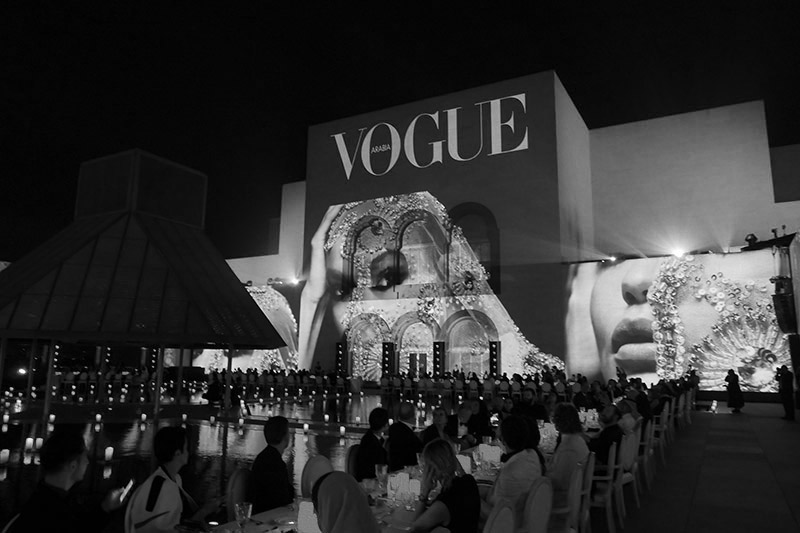 Vogue Arabia launch party in Doha (2017)
Vogue Arabia launch party in Doha (2017)
CONTEXT
With the rise and lasting success of fashion blogs and e-publishing, traditional print publications have been declared dead on several occasions. Yet, the number of print fashion titles has nevertheless multiplied and become more diverse – Vogue for instance has added a new international title to its portfolio with Vogue Arabia as late as 2017. New print magazines are more culture-specific. They cater to a small niche, have a particular aesthetic or writing style and move away from the mainstream towards authenticity.
Criticising the relationship between ad revenue and content as well as contributors’ bias created through consulting for the same brands they are supposed to report on, alternative fashion media counter this by becoming ad-free and taking on a more critical stance. New media are often initiated by academics or professionals who feel like conventional outlets remain at the surface level and do not put enough emphasis on underlying and more pressing themes.
In alternative fashion media, stronger opinions are expressed, yet they recognise the opinion of others as well. Diversity is regarded as an asset and uncomfortable conversations deemed essential for progress. Traditional publications have noticed the shift and are slowly adopting some of the changes pioneered by alternative media by creating their own additional channels such as British Vogue ’s multiple youth-oriented Youtube series and ELLE’s ‘Fashion for All’ inclusive video campaign. They make an effort to react to criticism concerning the propagation of a single body type or ethnicity by including more diverse models. However, these adjustments sometimes appear inauthentic as they seem to fit into the traditional framework as something to be ticked off.
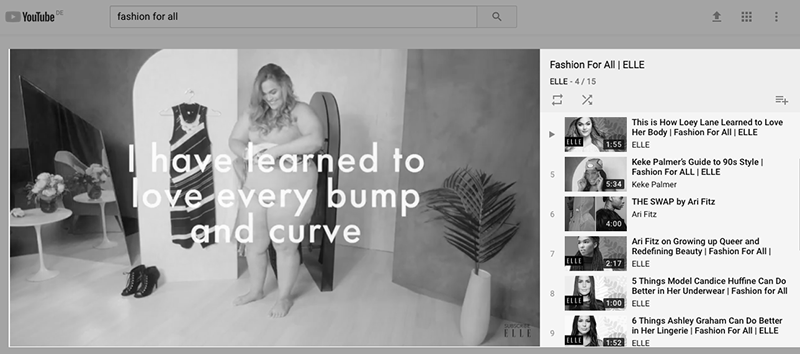
Condé Nast’s LGBTQ media brand them takes a leap in trying to reflect cultural changes and yet it has already attracted criticism before its release. The name of the venture, especially its use of the domain name them.us still belongs to a framework that highlights otherness, perpetuates division and fails to reflect the multiplicity it seeks to stand for. It may have been intended as an attempt to reclaim a derogatory ‘them’ the same way as ‘queer’ was reclaimed in the 1980s. Yet the emphasis on the division makes it appear more ‘about’ LGBTQ culture than ‘for’ everyone, although the manifesto rather ambiguously states ‘We are them. And them is about all of us.’
Instead of filling quotas and projecting an inclusive image, the public expects true diversity that extends to the staff that is employed as well. In this department, Condé Nast’s new platform claims to choose advertisers and contributors more carefully, dissuading those who only seek a ‘diversity project’. If not only considered a passing trend, this could lead to durable change across its portfolio. In the meantime, less known publications are leading by example.
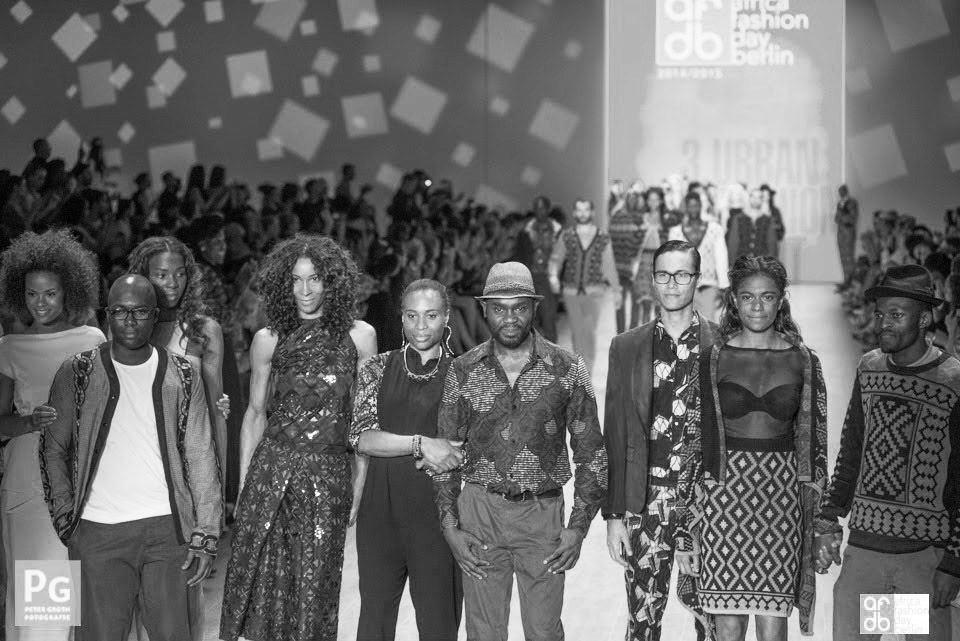 Africa Fashion Day Berlin (2015)
Africa Fashion Day Berlin (2015)
As long as groups feel left out or misunderstood, there will be space for alternative publications to widen the discourse around fashion. Simultaneously, publications that are fighting for specific causes are uncovering what is hidden from the public or addressing injustices that need to be resolved. There are also examples of alternative media that just want to explore different ways of doing fashion in order to keep it new and relevant. What they all have in common is their ambition to talk to their communities and to change the public perception about fashion.
CASE STUDIES

– Syntax/144 by researcher, academic and activist Otto von Busch is ‘a method for a radical democratic fashion magazine’. This open-source (or ‘copy-left’) zine can be curated by anyone by following instructions on his website Selfpassage . Meant to be a ‘channel for free speech and visual multitudes’, it seeks to dismantle traditional fashion publications’ hierarchical structures and to help to promote local talent as well as expressions of fashion that would not usually be picked up by mainstream fashion media. However, instead of opposing the latter, von Busch sees the publication as a complement to them. Syntax/144 extends content to include what was missing. In line with this, von Busch proposes an alternative method of distribution as well: copies of Syntax/144 should be placed ‘inside other magazines in local shops, boutiques or libraries’ to be discovered by chance.
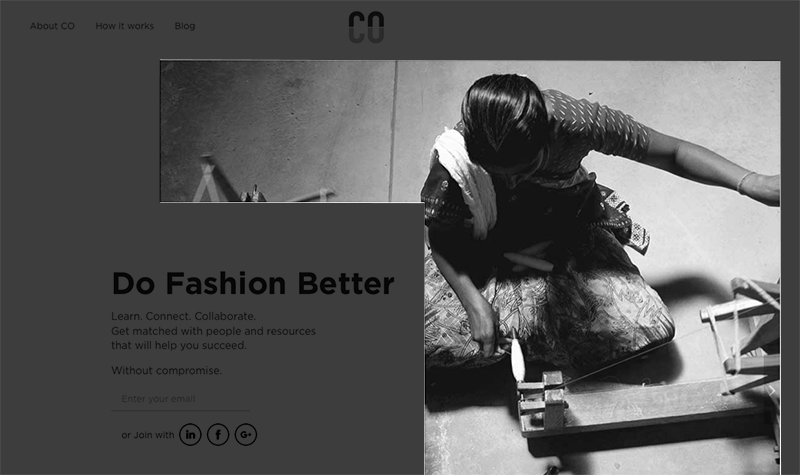
– Common Objective (initially named Mysource) is a platform launched by Ethical Fashion Forum in 2017 that uses matchmaking technology to connect sustainable fashion businesses and those interested in becoming more sustainable with fitting suppliers. In addition to making networking easier, it educates users about sustainable developments in the industry, shares success stories and provides resources to guide them. Current sustainable practice is not mandatory to join the platform, but it is rewarded with more visibility and buyer connections. This tactic is used to reach a wider audience beyond those already involved and to create ‘a level playing field, in which sustainability becomes an opportunity, rather than a cost’. The platform aims to educate and help create successful businesses that make better choices for the people working for them and for the environment. It goes beyond sharing information and facilitates real-life cooperation.
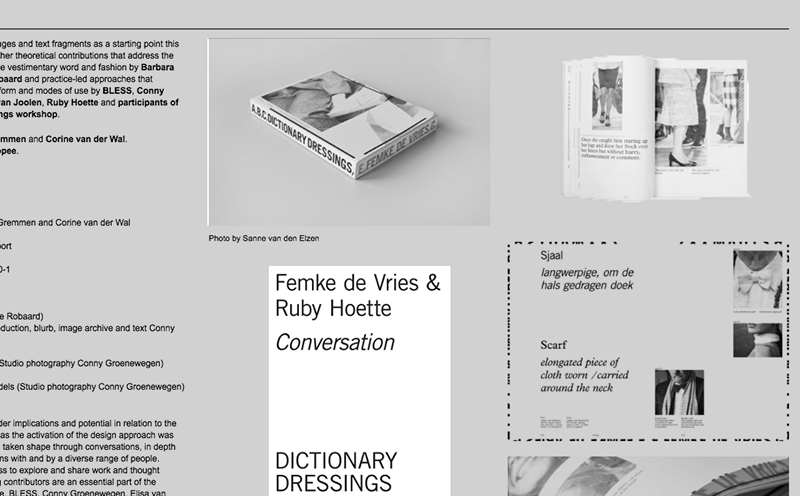
– Dictionary Dressings is an ongoing research project by Femke de Vries that takes rational descriptions of garments as they are found in dictionaries and then illustrates them through non-fashion-related imagery, text and objects. The discrepancy between rational definitions and fashion’s style influence on these body coverings become obvious and new clothing categories emerge. Traditional styles are questioned and garments’ re-readings open up a new experimental approach to design that draws directly from theory while questioning assumptions we might have about clothing. The project is a multidimensional exploration of fashion that expresses itself through various media, including exhibitions that bridge the gap between theory and practice as well as between making and writing about fashion. Collected fragments around clothing terms grow into an ever-changing interactive archive that aims to expand, instead of restrict, what is possible in fashion.

– Alternative fashion media make use of the spoken word to tackle topics below the visual surface of fashion. A great example of this is Fashion Revolution Podcast that addresses labour conditions in production locations and pushes for more transparency in the supply chain. In line with the medium, it gradually uncovers hidden stories and involves investigative reporting as well as interviews with observers, activists and decision-makers as well as those directly affected by the material production of fashion. It follows a similar approach to Behind the Thread , that explored issues such as sustainable cotton production and false labeling of source materials. Along the same lines but with a focus on brands and one-to-one interviews is Conscious Chatter, which showcases best-practice examples when it comes to fair and sustainable fashion production and asks about the motivations of the makers. Podcast format leads attention away from aesthetics and consumer desire towards silenced voices. Amplified without the necessity of shock-value often sought in news imagery, the urgency for change becomes clear and the listener is presented with long-term solutions instead of a call for short-term humanitarian relief. Hearing the voices directly without the distance created through writing, the public is addressed personally and hopefully becomes more engaged.
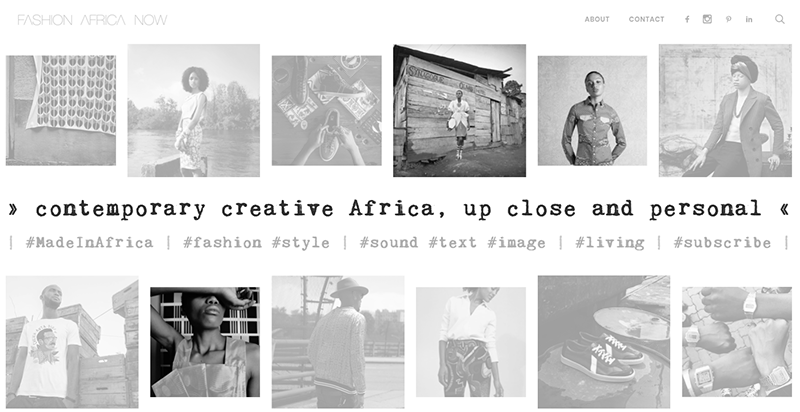
– Fashion Africa Now is a multidisciplinary creative platform that features practitioners from Africa and African diaspora. It is a platform created by APYA Productions, a Hamburg-based PR agency, that works to extend the reach of African creatives into European markets through media, shows, installations, exhibitions and film. Fashion Africa Now showcases their work and seeks to strengthen creative industries both locally and through international partnerships. Having established Africa Fashion Day during Berlin fashion week, it succeeded in giving African labels a wider audience and reaching a new market. The aim of platforms such as Fashion Africa Now is to group people together to multiply visibility and international recognition. By becoming an established presence at traditional events such as fashion weeks, new groups challenge narrow views of what fashion can be, present non-Western perceptions of beauty and add much-needed creative diversity. This could be a step towards trading romanticized cultural appropriation for genuine cultural and creative exchange where all participants get an equal say.
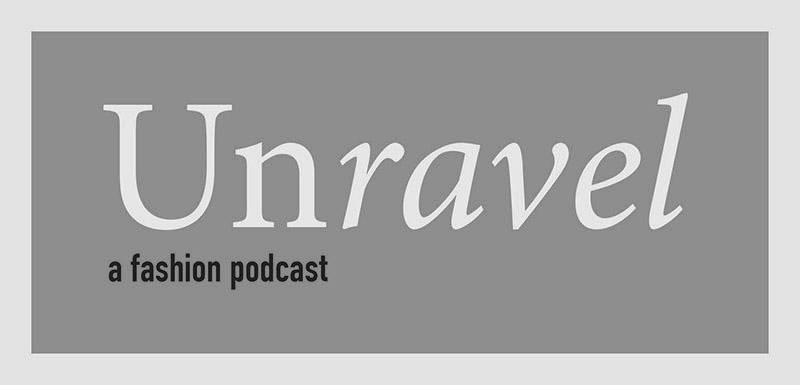
– Another podcast with a different focus is New York-based Unravel, founded by a group of former FIT students who seek to make fashion history more accessible to wider public. One-hour long episodes are recorded mainly in the form of interviews and roundtable discussions covering topics from cultural appropriation and body image to drag history and cosplay, with thoroughly researched background information and critical analysis. The show re-examines some overlooked aspects of fashion and fashion history such as Native American costume, pre-colonial styles and pregnancy attire. Guests include educators, historians, museum curators, artists and stylists who talk about their current books, exhibitions and research.
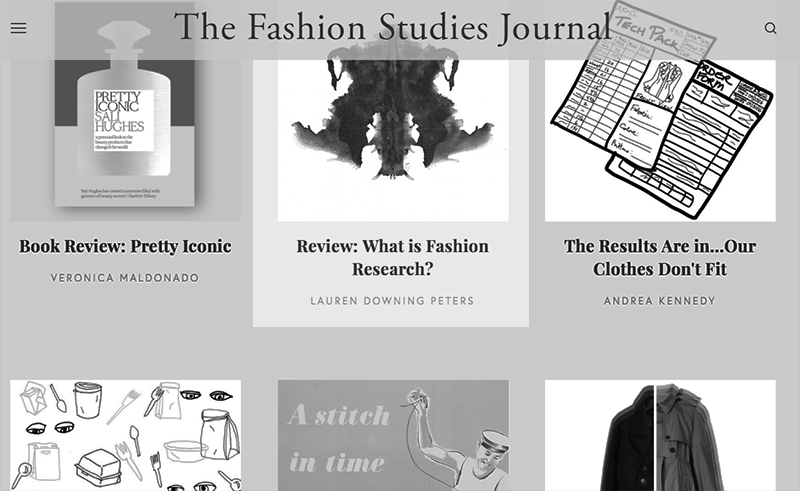
– Initially student-led, Fashion Studies Journal emerged in 2012 from Parsons School of Design’s MA Fashion Studies program as an academic online platform and testing ground for graduate-level writing. Since 2016, it widened its focus to become more accessible for readers beyond academia, covering contemporary fashion as well as fashion history and theory. Contributors range from emerging academics and journalists to established practitioners. They form a network that exchanges ideas beyond the online platform through workshops, dinners and book clubs. Instead of a blind peer review process, one-to-one reviews encourage dialogue and collaboration. As more Fashion Studies courses are on offer, online publishing platforms are being created by former students and many of the courses come with their own affiliated publications such as Marguerite by MA Fashion Cultures course based in London College of Fashion. Not only there to represent a cohort or a school, they serve as experimental spaces to test new approaches to fashion publishing and provide valuable feedback to emerging writers. Since they originate from small offline communities such as classrooms, their activities often extend into intimate gatherings that lead towards further collaborations.

– The product of a collaboration between former Vestoj online editor Laura Gardner and graphic designer Karina Soraya, Mode and Mode is a fashion periodical that explores experimental publishing as a fashion practice. Each issue uses a different style and is centered around an interview about a print project. Previous issues shed light on the works of experimental fashion archivist Shahan Assadourian, designer Seth Shapiro and design collective BLESS. Mode and Mode is about print’s potential for critical reflection on fashion and widening its discourse. It discusses alternative projects while at the same time becoming an object of the discourse itself.
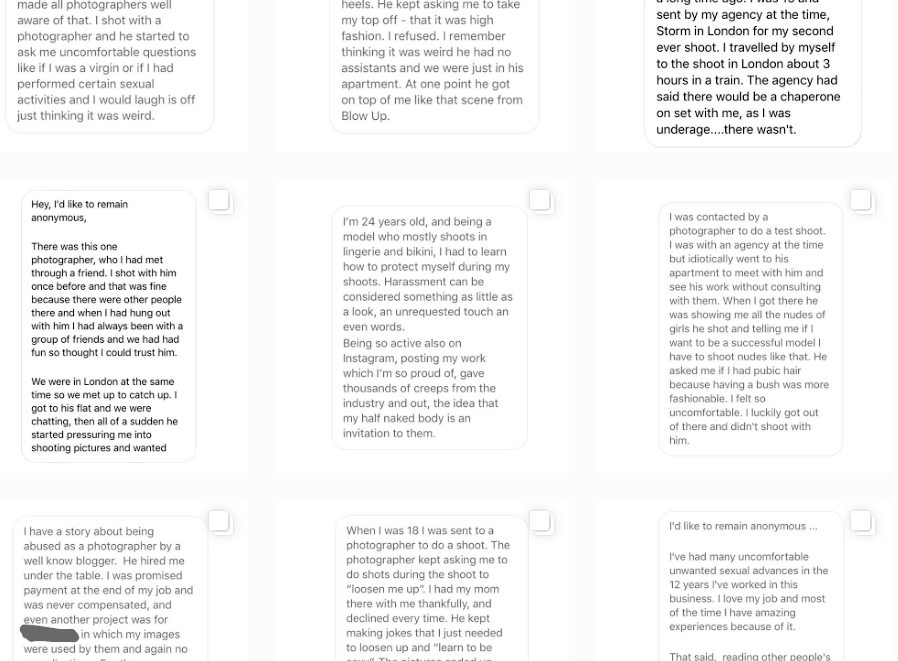
– Model and activist Cameron Russell used her Instagram account to uncover hidden abuse in the modeling industry under the hashtag #myjobshouldnotincludeabuse. In light of the Harvey Weinstein revelations, Russell started to publish screenshots of messages by fellow models with personal stories of sexual assault in the workplace. Their identities remain anonymous, yet their stories appear similar and cause others to speak out as well, highlighting the vast extent of the issue and urging for more solidarity. Russell’s use of social media demonstrates how the tool can be used as an educational activist platform within existing channels. She combines information, first-person accounts and calls to action towards industry professionals with a discussion that reaches both those directly affected and those who were previously unaware. Alternative fashion media not only create new outlets but hack into existing ones where they can change the perceptions of those who consume products of immoral work practices.
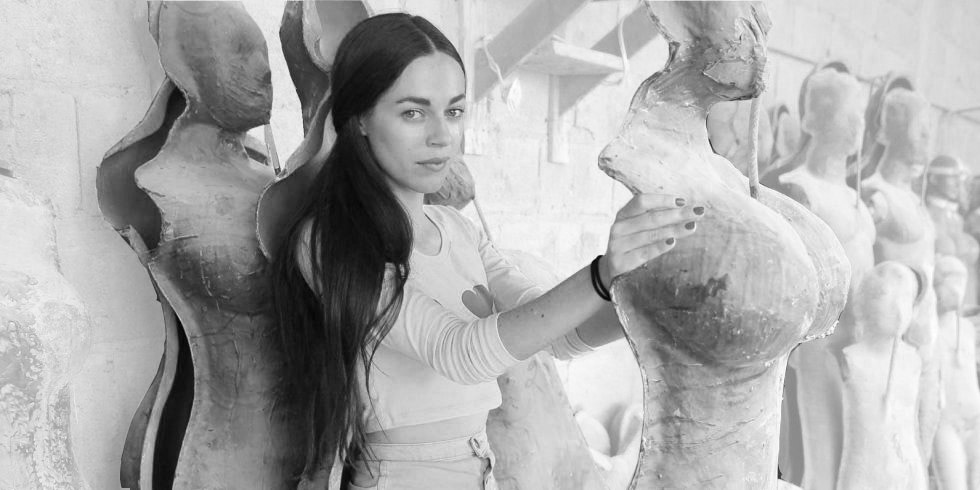
– States of Undress is a video docu-series launched in 2016 by Viceland, the TV channel of Vice Media. Trained journalist and model Hailey Gates visits different countries to report on the local fashion scenes, spanning government-supported fashion weeks, emerging designers, subcultures and couture. To give a more complete image, however, the series investigates the untold stories behind those events, uncovering complex situations such as a Hezbollah-supporting Lebanese designer working with a Syrian tailor who fled Assad’s regime or the extensive cosmetic surgery behind beauty contests in Venezuela that severely affect Venezuelan identity and self-worth. States of Undress doesn’t shy away from social and political issues and aims to make the complexity of the fashion system more understandable to a wider public. While the series started from a rather Americentric viewpoint with minimal understanding of other cultures, it gradually shifted its focus away from Western-influenced elites to give more screen-time for those affected by the decisions of the former. Increasingly, a more balanced overview of multiple voices in each country was laid out and the presenter became more self-aware of her own complex position as a white, American, educated woman, which affords her many privileges while at the same time not protecting her from sexism and anti-American as well as anti-white sentiments.
→
Gathering common motivations that unite a broad range of practitioners, ‘FASHION FROM THE SHADOWS’ -series aims to map alternative approaches to thinking, creating, presenting and discussing fashion. It provides an overview of recent developments in the discipline in order to integrate them into a new and more inclusive fashion system that encourages discussion. Instead of being suppressed, these alternatives broaden fashion’s spectrum of activities and help to provide a more complete understanding of the spirit of the time which fashion has always sought to reflect.